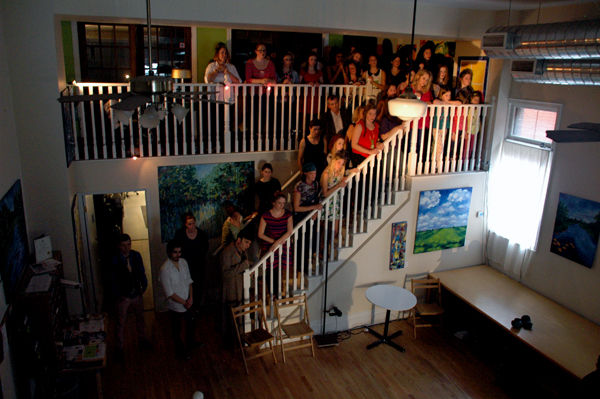ACROSS OCEANS ARTS: PROGRAMS
KRIMA!
Big work, low tech, non-theatre

Barrie, ON (2014, 2015), Toronto, ON (2009, 2011), Hamilton, ON (2009), Athens, GREECE (2006)
CATHARSIS JOY SUPPORT RESOLVE. Let's bring KRIMA to your community.
“Maxine Heppner’s massively scaled project challenged our complacency and swept us up in a sea of 140 dancers... a series of powerful vignettes... a Noah’s ark of survival and dignity.”
Glen Sumi, 2009
“a coups… one of the top-10 shows of 2009”
Toronto NOW Magazine

“simple in their power”
Jon Kaplan, 2009
“Audacious choreographer.
Nurture and survival...headlines writ large.”
Paula Citron, 2009
about KRIMA!
“A sense of belonging, making people aware of different life situations and persecutions”
THINGS happen to good people in unexpected places, suddenly.
Just when least expected, a drink spills, a window breaks, a siren screams, the world becomes loud…or silent.
“ KRIMA!” we say, a smile in our voice, when the something is melodramatic, ultimately inconsequential.
“ KRIMA!” we say, in a totally different voice, when the something forces itself deeply into our lives.
What does Krima! mean? Krima is a Greek expression meaning “what a shame” or “quel dommage” (from ancient Greek meaning “crime”) When someone says “ti krima” they may be teasing a friend, or they may be actually acknowledging that an event is “shameful” and should never be allowed to happen.
The KRIMA project: Life is full of surprises, good and bad, personal and global, horrific and mundane. Still we carry on. KRIMA is a dance and inter-arts project that leads participants to consider that we not immune to events that seem to happen only to people “less fortunate”, and that our human spirit is remarkably resilient, creative and generous.
Glen Sumi wrote “How can we sit by while tragedies are happening all the time? Maxine Heppner’s massively scaled project challenged our complacency and swept us up in a sea of 100 dancers, who crowded the Young Centre lobby in a series of powerful vignettes, some suggesting a Noah’s ark of survival and dignity.” (Now)
The theme is gentle, harsh, pragmatic, and philosophical about life, hardship and the resilience of human relationships.
The project looks at the realities of “How do we get by, day-by-day?” through creation, reflection, discussion and performance. The project involves over 100 performers from all backgrounds to dance, make music, write, and create craft arts, learning prepared material and personalized creation to reflect and include local participants’ talents, skills and interests. Exchange between performers and with the public is core to the project’s environment.
The outcome is deeper awareness and new relationships between people and within communities through the shared experience of art-making.
community response
Participants
a selection from over 800 to date
“People I encountered had powerful life stories to share about themselves, family members and life …sad/inspiring stories of survival and hope…life isprecarious and you never know what’s around the corner…courage, faith, support and hope get you through the hard times…”
“It’s important to advocate for the arts and to get it out there. Small cities are often sheltered. The arts are for everyone. Projects that involve everyone are more meaningful.”
“It was fun. The work was of excellent quality. Interesting people were involved and I got to meet them. Art is a powerful way to communicate.”
“Art has the power to highlight issues in our society that need addressing – making you look at things we tend to overlook.”
“It was great to see how the professional artists were accepted by Busby visitors/participants and to see the impact the artists presence had on people -wonderful & enlightening“
“The range of emotions us quite huge. Also the times also vary immensely throughout the process.”
“A sense of belonging, making people aware of different life situations and persecutions,”
“I felt a great sense of community”
Participating social workers, Busby Street Centre, Barrie Ontario, Nov 2015
“As someone who was dealing with 10 years of living in an unsafe environment and experienced personal trauma, I found the performance to be very vivid, touching on my intimate realities.”
“I found it interesting that I felt uncomfortable at times during the performance, considering I have life experience and work in this field every day. My discomfort was for the others watching the performance”,
“I am pleased that this expression of crisis took place in my community because it strengthens our ability as a community to talk about what makes us uncomfortable.”
Busby Street Centre Clients, Barrie Ontario 2015
(only first names allowed)
“I never imagined being a part of this kind of project. I was honoured and had a sense of pride that I accomplished something after losing my eyesight”
(Rob)
“I like to do things that give me purpose and meaning and helps build my confidence”
(Phil)
“I learned that when I put my mind to something I could do it”
(Nancy)
“I had more courage, you saw me for who I was. I felt a connection with you. You had faith in me”.
(Susie)
“Made me feel included for a change,”
(Marian)
“Glad to have something happy, different to do & being treated with respect”
(Anonymous)
KRIMA! - Image selection: Toronto (ON), Barrie (ON), Athens (GR) ensembles of 100-150 participants







































